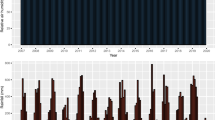Abstract
Fruit from the annual replicated yield assessments for the USDA-ARS strawberry (Fragaria ×ananassa Duchesne ex Rozier) breeding program at Beltsville, MD, 2007 and 2008, were evaluated for postharvest decay development after storage at 5 °C. Generalized linear genotype × year mixed model analysis of covariance with overdispersed binomial distribution, logit link function, and Laplace optimization method was used to determine the relationships between postharvest proportion decay and storage period (SP), season’s harvest number (HN), and genotype-specific harvest number through the season; conditioned on the confounding of harvest with SP. To determine if limiting analyses to replicates (plot × harvest combinations) with a minimum number of berries would increase statistical precision, concurrent analyses were conducted using data from replicates with more than: zero, three, and six berries. Limiting data to genotypes for which more than three or more than six berries could be evaluated, resulted in loss of data and reduced statistical power. Within the range of SP observed, 13–19 days, consistency among genotypes of the linear relationship between SP and logit postharvest proportion decay, unless strongly influenced by a confounded harvest effect, indicated all SP in the range tested provided equivalent ability to discern genotypes. The significant genotype × HN interaction effect indicated maximizing the number of harvests was preferable to limiting to a few “informative” harvests. The significant genotype × year interaction effect indicated the decision to release a genotype as a cultivar will demand multiple years of evaluation. Making determinations each year to discard genotypes or use them as parents for postharvest quality was best facilitated by the simple process of calculating arithmetic genotypic means for each harvest date separately, charting the results, and using the charts to visually assess genotypic performance trends across harvests.





Similar content being viewed by others
References
Barritt BH (1980) Resistance of strawberry clones to Botrytis fruit rot. J Am Soc Hortic Sci 105:160–164
Black BL, Enns JM, Hokanson SC (2002) A comparison of temperate-climate strawberry production systems using eastern genotypes. HortTechnology 12:670–675
Ceponis MJ, Cappellini RA, Lightner GW (1987) Disorders in sweet cherry and strawberry shipments to the New York market, 1972–1984. Plant Dis 71:472–475
Daubney HA, Pepin HS (1973) Variations in fruit-rot susceptibility of strawberry cultivars and selections as indicated by a postharvest screening technique. Can J Plant Sci 53:341–343
Daubney HA, Pepin HS (1977) Evaluation of strawberry clones for fruit rot resistance. J Am Soc Hortic Sci 102:431–435
Dobson AJ, Barnett A (2008) An introduction to generalized linear models, 3rd edn. CRC Press, Boca Raton
Gbur EE, Stroup WW, McCarter KS, Durham S, Young LJ, Christman M, West M, Kramer M (2012) Analysis of generalized linear mixed models in the agricultural and natural resources sciences. American Society of Agronomy, Soil Science Society of America, and Crop Science Society of America, Madison, WI, USA, 283 pp
Maas JL (1978) Screening for resistance to fruit rot in strawberries and red raspberries: a review. HortScience 13:423–426
Maas JL (1998) Compendium of strawberry diseases, 2nd edn. APS Press, St. Paul
Maas JL, Smith WL (1978) ‘Earliglow’, a possible source of resistance to Botrytis fruit rot in strawberry. HortScience 13:275–276
Mertely JC, MacKenzie SJ, Legard DE (2002) Timing of fungicide applications for Botrytis cinerea based on development stage of strawberry flowers and fruit. Plant Dis 86:1019–1024
Mertely JC, Seijo TE, MacKenzie SJ, Moyer C, Peres NA (2009) Effect of timing of preharvest fungicide applications on postharvest Botrytis fruit rot of annual strawberries in Florida. Plant Health Prog. http://www.plantmanagementnetwork.org/sub/php/research/2009/botrytis/ Accessed 23 Sep 2010
Mitcham E (2002) Strawberry. In: Gross KC, Wang CY, Saltveit, M (eds) The commercial storage of fruits, vegetables, and florist and nursery crops, USDA Agric. Hdbk No. 66, 8 Nov 2002. http://www.ba.ars.usda.gov/hb66/index Accessed 23 Sep 2010
Pelayo C, Ebeler SE, Kader AA (2003) Postharvest life and flavor quality of three strawberry cultivars kept at 5 °C in air or air + 20 kPa CO2. Postharvest Biol Technol 27:171–183
R version 2.14.1© (2011) The R foundation for statistical computing. www.r-project.org
Stroup WW (2012) Introduction to statistical modeling using generalized linear mixed models. Texts in statistical science. Chapman & Hall/CRC, Boca Raton
Sutton JC (1998) Botrytis fruit rot (gray mold) and blossom blight. In: Maas JL (ed) Compendium of strawberry diseases, 2nd edn. APS Press, St. Paul, pp 28–31
Watkins CB, Manzano-Mendez JE, Nock JF, Zhang J, Maloney KE (1999) Cultivar variation in response of strawberry fruit to high carbon dioxide treatments. J Sci Food Agric 79:886–890
Acknowledgments
This project was funded by USDA-ARS Projects 1275-21220-189-00 and 1265-42000-004-00. The authors wish to thank Jim Ballington for donation of breeding selections; John Enns, Phil Edmonds, and the BARC Research Support Services for establishing and maintaining the fields; Ellen Turner, John Enns, and Qiang He for evaluating fruit; George Meyers, RSS, for weather records; and Wayne Jurick, Gene Lester, John Maas, Lisa J. Rowland, and the anonymous reviewers for their helpful comments. Mention of trade names or commercial products in this publication is solely for the purpose of providing specific information and does not imply recommendation or endorsement by the U.S. Department of Agriculture.
Author information
Authors and Affiliations
Corresponding author
Rights and permissions
About this article
Cite this article
Lewers, K.S., Luo, Y. & Vinyard, B.T. Evaluating strawberry breeding selections for postharvest fruit decay. Euphytica 186, 539–555 (2012). https://doi.org/10.1007/s10681-012-0654-8
Received:
Accepted:
Published:
Issue Date:
DOI: https://doi.org/10.1007/s10681-012-0654-8



